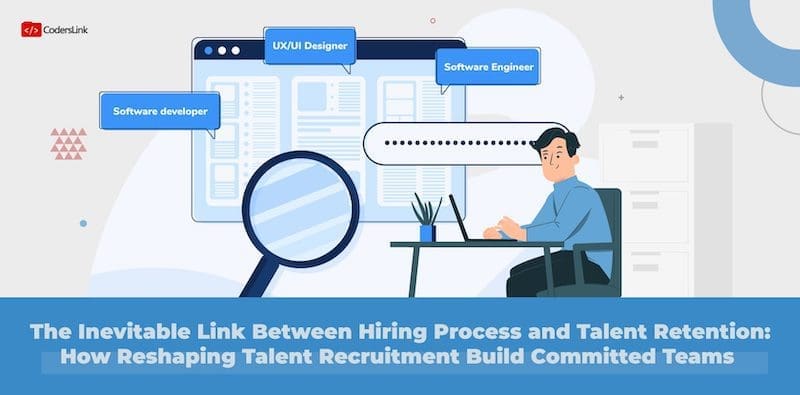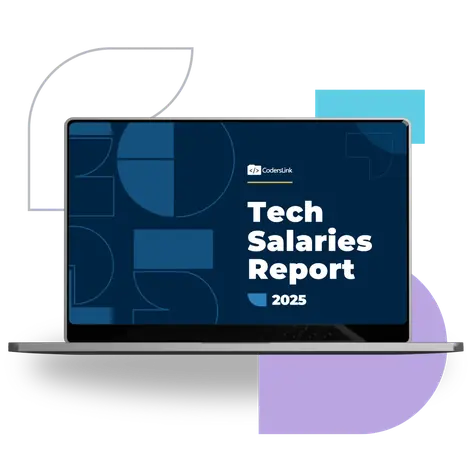
Attrition rates are high in the tech industry. Data suggests that professionals like software developers and engineers stick around at the same job for about two years. So, what’s the solution to getting talent to stick around? There are a myriad of talent retention strategies, but one way to improve retention rates is to think about the hiring process as part of your company’s retention efforts.
After years of working in the recruitment arena, our team at CodersLink has picked up a few insights. The world of recruiting has changed in the last two decades. How companies hire, what candidates look for in a job, and how we think about work have all seen massive overhauls. This has all affected the hiring process and retention rates.
Statistics on Talent Retention in Tech
The tech industry is unique. It experiences perpetual ebbs and flows and— since covid— has seen incredible growth because of companies in all sectors seeking digital transformation. Despite the demand and salaries, however, the tech sector experiences some of the highest attrition rates.
According to LinkedIn, the turnover rate stands at 13.2%. This percentage is higher than in any other industry. Big tech companies are notorious for having low retention rates. People outside of the industry are often surprised to hear this since big-name companies are associated with being the dream jobs. Yet, Google has an average tenure of 1.1 years. Uber was not far behind with 1.8 years and about 2 years for Tesla and Dropbox.
Breaking the three-year barrier is a big deal in tech. Netflix is known for holding onto their employees for about three years and Apple for about five, which is top marks in the business. So, what does all this say about the tech industry or tech talent? And what have we learned from our time on the ground about how to build strong and committed teams?
Talent retention begins during the hiring and onboarding process. Given that many interviews and onboarding sessions are happening online without face-to-face interaction, companies need to be far more deliberate and precise with the way they bring on new team members.
3 Ways to Improve Hiring Outcomes When Building Remote Tech Teams
#1 Consider Candidate Experience in Your Hiring Process
The candidate experience begins before the interview. It begins with your job description, job advertisement, and initial conversations with the candidate. For many candidates, these are deciding factors.
Hiring for tech roles is unique in some ways. First off, the industry changes rapidly and dynamics shift as markets ebb and flow. For example, it wasn’t that long ago that tech employees would be pursued so aggressively by employers that they were often poached out of their current positions. After the massive layoffs, there has been a lot of reshuffling of talent.
Considering the candidate’s experience in the hiring process means that employers see the hiring process through the candidates eyes. In 2015, the Wall Street Journal identified one main difference between job posts that attracted the best candidates and those that didn’t. They suggested that it was the job descriptions that included what the company can do for a prospective worker—such as providing continuing training, on-the-job training, etc.—that received an increased number of qualified candidates.
There is certainly some truth to that from our experience. When a company demonstrates what the job offers as well as what the job re quires, candidates are much more inclined to apply.
#2 Develop Efficient, Effective, and Productive Onboarding Practices
As Harvard Business Review put it, the onboarding process makes or breaks a new hire’s experience. Our experience working in Mexico’s labor market has taught us as much. Before the pandemic, companies struggled to provide a structured and efficient onboarding process, but with the switch to remote and hybrid models, many businesses faced even bigger challenges.
The ideal timeframe for an onboarding process is a subject of debate among business leaders and managers. The standard suggests that onboarding lasts about 90 days. A Gallup report, however, suggested that it takes employees about 12 months to reach their full potential and, therefore, the onboarding process should really be considered as a much more long-term endeavor.
Data suggests that organizations that implement a consistent and standardized onboarding process will see a 62% increase in new hire productivity and a retention rate that is 50% greater than those without.
#3 Bring Your Company Culture to Your Hiring Process
Company culture goes far beyond Taco Tuesdays and Yoga classes. As LinkedIn CEO puts it, culture and values are “the foundation for building and enduring a successful company.” Because of this, companies should not only bring their culture to their hiring process but consider the role that hiring for cultural fit plays in successful outcomes. This means letting the company culture shine through but also establishing effective hiring processes that take cultural fit into account.
Employers want to make sure that new hires’ beliefs and behaviors are aligned to the established core values and company culture. Research by GlassDoor suggests that culture and values are one of the top three factors that workers across the board listed. The same data indicated that 77% of respondents admitted to considering a company’s culture before applying for the job. This means that the very job post needs to— in some form or other— bring forth your company culture.
The Cost of High Attrition Rate
Losing employees is a costly affair. According to SHRM, it costs a company about 6-9 months of an employee’s salary to replace them. That’s because losing a team member means the company will have to engage with the hiring, interview, and training process all during which the position goes unfilled.
Improve Talent Retention Strategies by Considering Your Hiring & Onboarding Process
At CodersLink, we build relationships with our network of talent in order to better understand their needs and the kinds of positions they are looking for. By knowing the tech industry and understanding the talent pool, our team gets better at seeking out opportunities for each individual candidate.
Connect with our team today and learn more about how we reduce time-to-hire and improve hiring outcomes.


